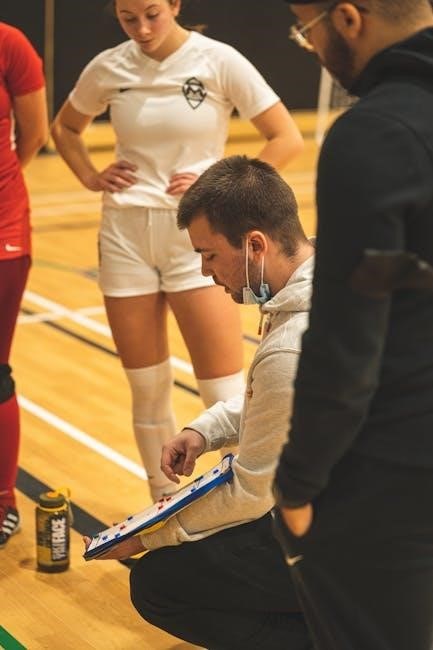basketball practice plan template pdf

A basketball practice plan template is a structured guide for organizing drills, activities, and strategies․ Coaches can customize these templates to suit their team’s needs, ensuring efficient practices․
1․1 What is a Basketball Practice Plan Template?
A basketball practice plan template is a structured guide for organizing drills, exercises, and activities during training sessions․ It provides a detailed outline, including time allocation for warm-ups, skill development, and game scenarios․ Coaches can customize these templates to suit their team’s skill levels and objectives․ The template often includes sections for points of emphasis, notes, and announcements, ensuring practices are focused and productive․ Available as downloadable PDFs, these templates are ideal for coaches at all levels, from youth to high school basketball․
1․2 Importance of Using a Practice Plan Template
Using a practice plan template ensures structured and organized training sessions, saving time and enhancing productivity․ It provides a clear roadmap for coaches, helping them cover essential drills, skills, and strategies․ Templates promote consistency, allowing teams to build routines and improve progressively․ They also enable coaches to allocate time efficiently, ensuring a balance between skill development and conditioning․ By using a template, coaches can maintain focus on key objectives, leading to better player accountability and overall team performance․ This tool is versatile, catering to various skill levels and age groups, making it indispensable for effective coaching․

Structure of a Basketball Practice Plan
A basketball practice plan typically includes warm-ups, skill drills, game scenarios, and cool-downs․ It outlines time allocations for each activity, ensuring a balanced and efficient session․
2․1 Time Management and Organization
Effective time management is crucial for maximizing practice efficiency․ A structured basketball practice plan template divides the session into timed intervals, allocating specific durations for warm-ups, drills, and game scenarios․ This ensures that each activity is covered without overlap, allowing coaches to maintain focus and achieve set objectives․ Proper organization also helps in transitioning smoothly between exercises, minimizing downtime and keeping players engaged throughout the session․ A well-organized plan fosters discipline and productivity, essential for team success․
2․2 Warm-Up and Stretching Routines
A well-structured warm-up is essential for preparing players physically and mentally․ Basketball practice plan templates often include dynamic stretches and light cardio exercises to increase blood flow and flexibility․ These routines typically last 10-15 minutes, focusing on leg swings, arm circles, and high knees to activate key muscle groups․ Proper warm-ups reduce the risk of injuries and enhance performance during drills and scrimmages․ Coaches can tailor these routines to address specific areas, ensuring players are ready for the demands of practice․
2․3 Skill Development Drills
Skill development drills are a cornerstone of effective basketball practice plans․ These exercises focus on improving specific abilities such as shooting, dribbling, passing, and defense․ Templates often include age-appropriate drills, ensuring activities align with players’ skill levels․ For example, youth teams might practice basic ball handling, while advanced teams work on complex moves․ Drills are typically timed and structured to maximize efficiency, allowing players to repeat and refine their techniques․ Incorporating game-like scenarios helps players apply skills in realistic contexts, enhancing their readiness for competition․

2․4 Game Scenario Simulations
Game scenario simulations replicate real-game situations, helping players prepare for various in-game challenges․ Templates often include drills like end-of-game plays, fast breaks, and defensive stops․ These simulations allow teams to practice decision-making, communication, and execution under pressure․ Coaches can customize scenarios based on upcoming opponents or specific team needs․ Players benefit by learning to think critically and react instinctively, which builds confidence and readiness for actual games․ These simulations are a valuable tool for translating practice skills into competitive success․ They enhance teamwork and adaptability, key elements for achieving victory․

Key Components of a Basketball Practice Plan
A basketball practice plan includes drills, exercises, and activities aimed at improving skills and teamwork․ It also outlines points of emphasis and documentation for tracking progress effectively․
3․1 Drills and Exercises
Drills and exercises are the cornerstone of any basketball practice plan․ They are designed to enhance specific skills such as shooting, dribbling, and passing․ Coaches can choose from a variety of drills, including layup lines, free-throw shooting, and defensive stance exercises․ These activities are typically structured in 5-minute intervals to maximize efficiency during practice․ Proper form and technique are emphasized to ensure players develop strong fundamentals․ Additionally, these drills can be tailored to different age groups and skill levels, making them versatile for any team’s needs․ Safety and proper execution are always prioritized to prevent injuries and foster improvement․
3․2 Points of Emphasis
Points of emphasis are key areas coaches highlight to ensure players understand the focus of each practice․ These may include proper shooting form, defensive stance, or teamwork․ By emphasizing specific skills, coaches can guide players toward improvement․ Examples include focusing on layup techniques or communication during drills․ These points are often highlighted in the practice plan template to remind coaches and players of the session’s objectives․ They help maintain structure and alignment with the team’s overall goals, ensuring practices are productive and targeted․ Proper execution and safety are also emphasized to foster a positive learning environment․
3․3 Documentation and Notes
Documentation and notes are crucial for tracking progress and planning future sessions․ Coaches can record player performance, drill effectiveness, and areas needing improvement․ Notes may include adjustments made during practice, player feedback, and observations on team dynamics․ Many templates provide sections for documenting attendance, injuries, and equipment needs․ This ensures coaches have a clear record of each session, aiding in long-term development strategies․ Regular documentation also helps in evaluating team growth and making data-driven decisions for upcoming practices and games, fostering continuous improvement and accountability․

Benefits of Using a Practice Plan Template
Using a basketball practice plan template ensures structured practices, enhances team organization, and improves skill development while saving time and increasing efficiency․
4․1 Improved Team Organization
A basketball practice plan template enhances team organization by providing a clear structure for each session․ Coaches can allocate time for drills, scrimmages, and conditioning, ensuring no activity is overlooked․ This structured approach helps prioritize key skills and maintains focus throughout practice․ Players benefit from a consistent routine, understanding their roles and responsibilities․ The template also allows for adjustments based on team needs, promoting adaptability․ By organizing practices effectively, coaches can maximize efficiency, ensuring each session contributes to overall team improvement and preparation for games․ This structured method fosters a disciplined environment, essential for success․
4․2 Enhanced Focus on Key Skills
Using a basketball practice plan template allows coaches to emphasize specific skills, such as shooting, dribbling, or defense․ By structuring drills around these areas, players can improve targeted abilities; The template ensures each practice is purposeful, with activities designed to build proficiency․ This focused approach helps players develop a stronger foundation, leading to better performance in games․ Coaches can also track progress and adjust drills as needed, ensuring continuous skill enhancement․ This methodical focus on key skills fosters a more effective and efficient learning environment for the team․
4․3 Better Player Accountability
A basketball practice plan template enhances player accountability by providing clear expectations for each session․ Coaches can outline specific goals, drills, and roles, ensuring players understand their responsibilities․ The structured format allows for progress tracking, helping players stay focused and motivated․ By documenting individual and team objectives, the template fosters a sense of ownership and commitment․ This accountability translates to improved effort and dedication during practices, ultimately leading to better performance on the court․ The template serves as a tool to keep players engaged and driven toward collective success․

How to Create a Basketball Practice Plan Template
Start by identifying team goals and structuring time for drills, warm-ups, and skill development․ Include sections for notes and points of emphasis to ensure comprehensive planning․
5․1 Identifying Team Goals and Objectives
Identifying team goals is crucial for effective practice planning․ Coaches should assess player skills, set specific objectives, and align drills with these targets․ For instance, if improving shooting is a priority, allocate more time to drills focused on form and accuracy․ Additionally, consider the team’s strengths and weaknesses to tailor activities that address gaps and enhance overall performance․ This ensures practices are purposeful and contribute to long-term success․ Clear goals guide the structure of each session, making practices more productive and focused․
5․2 Allocating Time for Each Activity
Allocating time effectively is essential for a balanced practice․ A typical 90-minute session might include 10-15 minutes for warm-ups, 30-40 minutes for skill drills, and 20-30 minutes for game simulations․ Coaches should divide the practice into 5-minute intervals, ensuring each activity transitions smoothly․ This structured approach maximizes efficiency, keeps players focused, and allows for adequate time on key areas like conditioning and strategy․ Proper time allocation ensures all aspects of the game are addressed without overwhelming the players․
5․3 Incorporating Conditioning and Strength Training
Incorporating conditioning and strength training into practice plans enhances player endurance and power․ Coaches can integrate agility drills, sprints, and plyometrics to improve speed and explosiveness․ Strength training exercises, like bodyweight routines or resistance bands, can be included to build muscle․ These activities should be balanced with skill work to avoid fatigue․ Proper conditioning ensures players can perform at their best throughout the season, reducing injury risks and improving overall performance on the court․

Customizing Your Practice Plan
Customizing your practice plan ensures it aligns with your team’s specific needs, skill levels, and goals․ Tailor drills, exercises, and activities to maximize player development and engagement․
6․1 Adjusting for Different Age Groups
When creating a basketball practice plan, it’s essential to adjust activities based on the age group․ For younger players, focus on fundamental skills and fun, incorporating shorter drills to maintain attention․ For older groups, introduce more complex strategies and conditioning․ Templates often include sections to tailor drills, ensuring practices are age-appropriate and effective․ Proper adjustments help maximize skill development and engagement across all age levels․
6․2 Tailoring Drills to Team Skill Levels
Effective practice plans adapt drills to match the team’s skill levels․ For less experienced teams, focus on basic techniques like dribbling and shooting․ Advanced teams can engage in complex strategies and situational drills․ Templates often include scalable exercises, allowing coaches to adjust difficulty․ This ensures every player is challenged appropriately, fostering growth and teamwork; Customizing drills maximizes efficiency and keeps practices engaging for all skill levels․ Adjustments are crucial for optimal development and player confidence․ Incorporating feedback helps refine drills further, ensuring they meet the team’s evolving needs․ This approach ensures a balanced and productive practice environment․ Players benefit from tailored challenges, leading to improved performance․ Coaches can track progress and make necessary adjustments to maintain a competitive edge․ Continuous adaptation is key to sustained success in basketball training․

Examples of Basketball Practice Plan Templates
Examples include youth, high school, and elite-level plans․ Age-specific templates cater to developmental needs, while skill-based templates focus on enhancing particular abilities․ Downloadable PDFs offer customization options for coaches․
7․1 Youth Basketball Practice Plans
Youth basketball practice plans are designed for young players, focusing on skill development and fun․ These plans include age-appropriate drills, such as basic dribbling, shooting, and teamwork exercises․ Templates often emphasize short, engaging activities to maintain attention spans․ Many resources, like the YMCA, offer downloadable PDFs tailored for ages 5-12, ensuring practices are both educational and enjoyable․ Coaches can customize these plans to fit their team’s specific needs and developmental goals, fostering a love for the game while building fundamental skills․
7․2 High School Basketball Practice Plans
High school basketball practice plans are detailed and structured to enhance advanced skill development․ These plans often include drills focusing on offense, defense, and conditioning․ Many templates, such as the 11-page PDF plans, provide organized schedules for improving teamwork and strategic play․ Coaches can customize these plans to address specific areas like shooting, ball handling, and game scenarios․ The templates also incorporate warm-ups, cool-downs, and safety measures, ensuring well-rounded and effective practices that prepare players for competitive games and tournaments․

Key Considerations for Effective Practice Planning
Ensure proper warm-up and cool-down routines, balance skill development with conditioning, and incorporate safety measures to prevent injuries and promote a productive practice environment․
8․1 Ensuring Proper Warm-Up and Cool-Down
A proper warm-up prepares players for physical activity, preventing injuries and improving performance․ Include dynamic stretches, light cardio, and muscle activation exercises․ Cool-down routines, such as static stretching, help reduce muscle soreness and promote recovery․ Both phases should be tailored to the team’s needs and skill levels․ Coaches should allocate adequate time for these routines, ensuring players transition safely into and out of intense practice sessions․ A well-structured warm-up and cool-down enhance overall practice effectiveness and player well-being․
8․2 Balancing Skill Development and Conditioning
Basketball practices should strike a balance between skill development and conditioning to ensure players improve both their technical abilities and physical fitness․ Allocate time for drills that enhance shooting, dribbling, and passing, while incorporating conditioning exercises like sprints and agility drills․ This balance prevents burnout and ensures players are well-prepared for game demands․ Properly integrating these elements keeps practices engaging and effective, fostering overall player development and team success․ Coaches should tailor activities to the team’s fitness levels and skill goals for optimal results․
8․3 Incorporating Safety Measures
Safety is a critical component of any basketball practice plan․ Coaches should ensure proper equipment is available, such as basketballs, cones, and first aid kits․ Drills must be designed to minimize injury risks, with emphasis on proper form and technique․ Players should be grouped by skill levels to avoid collisions․ Age-specific safety considerations, like shorter practice durations for younger players, should be incorporated․ Templates often include sections for safety protocols, ensuring a secure environment for players to develop their skills effectively and confidently․
A well-structured basketball practice plan template is essential for improving team performance․ It enhances organization, skill development, and teamwork, ensuring effective practices and successful outcomes for all players․
9․1 The Role of a Practice Plan in Team Success
A well-designed basketball practice plan template is crucial for team success․ It ensures practices are organized, focused, and aligned with team goals․ By outlining drills, skills, and strategies, coaches can maximize efficiency and player development․ A structured plan also promotes accountability and consistency, helping teams build cohesion and improve performance․ Regular use of practice plans fosters better communication and preparation, leading to stronger execution during games․ With customizable templates available for various skill levels, coaches can tailor practices to meet specific needs, enhancing overall team success and achieving seasonal objectives effectively․
9․2 Encouraging Coaches to Use Templates
Basketball practice plan templates are essential tools for coaches to streamline preparation and enhance team performance․ They provide a structured framework, saving time and ensuring practices are well-organized․ Coaches can customize templates to fit their team’s needs, whether for youth, high school, or professional levels․ Using templates also allows for better focus on skill development and strategy․ With readily available PDF formats and customization options, coaches can easily adopt these templates to improve efficiency and effectiveness․ Encouraging coaches to use practice plan templates can lead to better team outcomes and a more cohesive approach to training․

Additional Resources
Find free basketball practice plan templates online, including PDF formats, customizable tools, and guides from websites like Basketball Manitoba and FIBA․ These resources help coaches create structured plans efficiently․
10․1 Where to Find Free Basketball Practice Plan Templates
Free basketball practice plan templates are available online, with websites like Basketball Manitoba and YMCA offering downloadable PDFs․ The Basketball Manitoba website provides forms for drills and activities, while the YMCA offers youth-specific plans․ Additionally, FIBA’s Start Coaching course includes templates for skill development․ Coaches can search Google using keywords like “youth basketball practice plan PDF” or “high school basketball practice plan template” to find customizable options․ These resources are ideal for coaches seeking structured yet flexible practice plans to enhance team performance and organization․
10․2 Tools for Creating Custom Practice Plans
Coaches can use online tools to design custom basketball practice plans tailored to their team’s needs․ Websites offer free templates that can be edited and downloaded as PDFs․ A free basketball practice plan creator allows coaches to choose templates and customize them in minutes․ Additionally, platforms like Basketball Manitoba and FIBA’s Start Coaching course provide downloadable forms and guides․ These tools enable coaches to create structured, personalized plans efficiently, ensuring practices are organized and focused on skill development and teamwork․